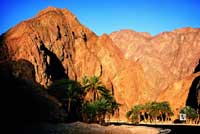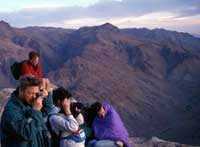|
Mount Sinai
(Jebel Musa,
or Mount Moses)
 John Lloyd Stephens said that "Among all the stupendous works of
Nature, not a place can be selected more fitting for the
exhibition of Almighty power. John Lloyd Stephens said that "Among all the stupendous works of
Nature, not a place can be selected more fitting for the
exhibition of Almighty power.
Mount Sinai is both the name of a
collection of peaks, sometimes referred to as the Holy
Mountains, and the biblical name of the peek on which Moses
received the Ten Commandments.
 Mount Mousa (or Musa), also
referred to as Jebel Musa, Gebel Mousa, Mount Moses or the
Mountain of Moses (all of which basically means the same thing)
is considered to be that biblical peak. Mount Mousa (or Musa), also
referred to as Jebel Musa, Gebel Mousa, Mount Moses or the
Mountain of Moses (all of which basically means the same thing)
is considered to be that biblical peak.
This peak has religious
significance: It is venerated by Christians, Jews and Muslims as
the site of the God’s revelation of the Ten Commandments, and in
Islam as the place where Mohammed's horse, Boraq, ascended to
heaven. The visitors are keen on climbing the mountain to watch
sunrise.
 The 7,497 foot mountain has 3,750 steps hewn out of stone by
monks of St. Catherine's Monastery, which is located just to the
North. The 7,497 foot mountain has 3,750 steps hewn out of stone by
monks of St. Catherine's Monastery, which is located just to the
North.
The peak is accessible by the steps, or by a gentler path
east of the monastery. Both lead to an amphitheater known as the
"Seven Elders of Israel". From there, one must ascend the
remaining 750 steps to reach the summit where the Chapel of the
Holy Trinity was built in 1934 (on the location of the original
chapel built in 363 and rebuilt by Justinian in 530) and affords
a truly breathtaking view.
 It is recommended that you take the
steps down, as they will lead you past the fountain of Moses, a
small chapel of the Virgin, and two arches, the Gate of St.
Stephen and the Gate of the Law. It is recommended that you take the
steps down, as they will lead you past the fountain of Moses, a
small chapel of the Virgin, and two arches, the Gate of St.
Stephen and the Gate of the Law.
There are other peaks in this range, some of which have also
been contested as the true Mount Sinai. Jebel Serbal is also a
candidate. Other peaks in this range include Jebel Megafa and
Jebel Moneiga. |